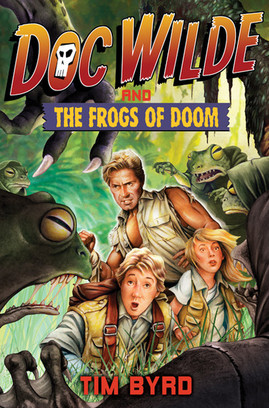Doc Wilde and the Frogs of Doom Review
Posted on January 21, 2011 by Kenneth Hite

Available at Amazon.com
The place of the pastiche in fiction is mixed at best: August Derleth’s Solar Pons is but a pale shadow of Sherlock Holmes, and the less said about Derleth’s “posthumous collaborations” with Lovecraft, the better. But in his collection of linked novelettes, Trail of Cthulhu, Derleth had the happy inspiration to combine the Cthulhu Mythos with Fu Manchu, and the result is a propulsive series of tales considerably above his usual mark. In Doc Wilde and the Frogs of Doom, Tim Byrd goes Derleth one better; he combines Lester Dent’s Doc Savage (as clearly as the laws of copyright will allow) and the Cthulhu Mythos – in the form of a young adult adventure mystery.
This last bit is the key element that elevates Byrd’s short novel above the ruck of mashup and pastiche, and Byrd has the tone of young adult fiction down pat. It’s not only a voice that suits him better than Dent’s manic testosterone or Lovecraft’s vertiginous cosmicism, it’s a voice that brings a welcome note of originality to what might otherwise be dismissed as derivative. The real protagonists of Doc Wilde and the Frogs of Doom aren’t Doctor Spartacus Wilde and “Grampa” Wilde (a 1930s adventurer still hale and hearty at 99, although he’s let his buzz cut grow out), but Doc’s kids Brian and Wren Wilde. By using 10-year-olds — albeit 10-year-olds trained in the arts of super-science, daredevilry, and adventuring — Byrd avoids (for the most part) the traps of the modern pulp: a hero who’s never in real danger, and a hero who wastes the pulp reader’s time on internal turmoil.
Instead, he presents a Doc Savage, er, “Doc Wilde” adventure through a kid’s excited eyes, in fresh language that recalls Blue Balliett or Anthony Horowitz rather than being imprisoned by its octogenarian sources. Despite our young heroes’ impressive abilities, the threat of the Frog God Frogon builds to a genuinely scary level by the end, with a properly Lovecraftian threat to the universe (and to one of Doc’s sidekicks, a burly Irishman named Declan mac Coul) waiting in the depths of a South American cave inhabited by the titular Frogs of Doom. Byrd plays with amphibian biology, and with plenty of other sciences from nanotech to aerodynamics, with the keen eye for the plausible impossibility shared by Dent, Lovecraft, and many of the pulp greats.
I suspect that readers out of middle school will appreciate Byrd’s tribute first and foremost as a tribute — spotting the references and shout-outs is our own little adventure mystery — but it will surprise you by engaging you with its youthful characters as well. The typography occasionally veers into the comic-book balloon or the wildly picturesque sort of font that seems like a good idea at the time; perhaps much younger readers aren’t tired of it yet. But the words themselves reel out at pulp speed, and tickle two kinds of nostalgia at once: nostalgia for reading Doc Savage, and for reading Doc Savage for the first time, when you were eleven and hadn’t yet talked yourself into being tired of heroes.
Review by Ken Hite


2 Responses to “Doc Wilde and the Frogs of Doom Review”